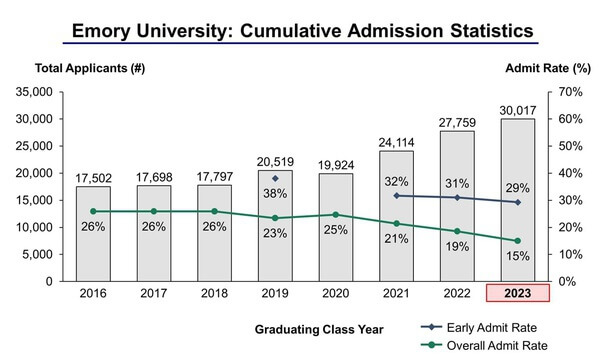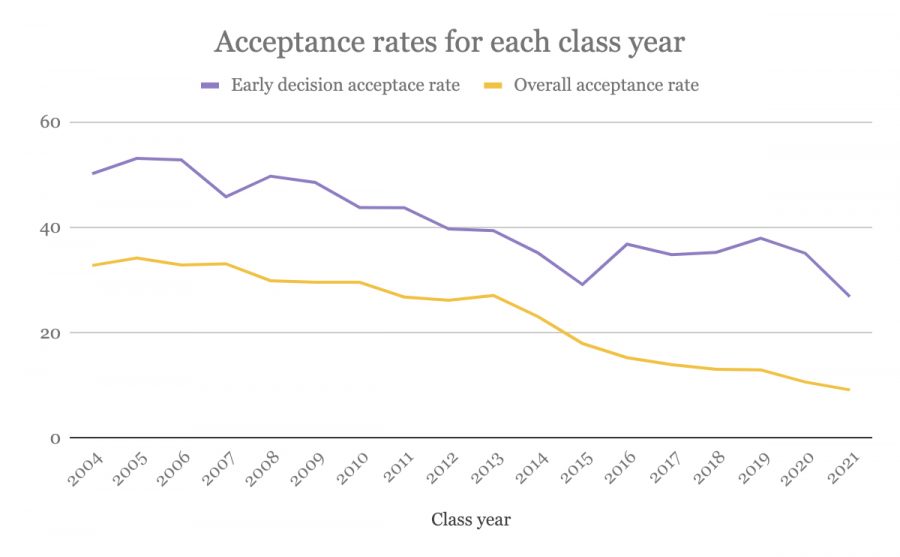Despite having the lowest acceptance rate in their school's history, so far, Penn has the highest acceptance rate among the Ivy League schools that released their data. On Tuesday, Dec. 12, Harvard University admitted just 964 students out of 6,630 applicants, an admission rate of just 14.5 percent to their early admissions program. Earlier on Wednesday, Princeton University sent out early action admission offers to 799 lucky school seniors to the Class of 2022, out of a record 5,402 applications. Princeton's acceptance rate was a record low with only 14.7 percent of student accepted.
For instance, at Columbia University, students who applied through the college's early decision program were four times as likely to get in than students who applied later. The school's early decision acceptance rate was 16%, whereas its acceptance rate for regular decision applicants was only 4%. The sheer increase in the number of applications received is the only reason for Penn's significantly smaller acceptance rate. More high school seniors are applying for early admission programs giving schools more quality applicants to choose from for their incoming class. This year Penn saw an increase of 9.5 percent from last year in the number of early decision applications they received, that number is 38 percent more from when the Class of 2018 applied in 2013. For the Class of 2021, Penn received what was then a record 6,147 applications.
Admission StandardsEliteApplicant CompetitionExtremeHow hard is it to get into Penn and can I get accepted? The school has a 8% acceptance rate ranking it #1 in Pennsylvania for lowest rate of acceptance. Last year, 3,740 out of 44,491 applicants were admitted making Penn an extremely competitive school to get into with a very low chance of acceptance – even for applicants with the highest scores and grades.
Academically, it has exceptionally high requirements for admission test scores, generally admitting students who score in the top 4 percent. University of Pennsylvania typically accepts and attracts "A-" average high school students. With over half of admitted students enrolling, acceptance by University of Pennsylvania is a prized outcome for many students. Most incoming freshmen graduated in the top ten percent of their high school class. The advantage of applying Early Decision is that acceptance rates for ED applications are sometimes two to three times higher than the Regular Decision admission rates at the same schools. For instance, Northwestern's overall acceptance rate is only 9%, but its early decision rate is closer to 25%.
Johns Hopkins University's jump is even bigger, from 9% to 31%. And the early decision rates at schools like Washington University in St. Louis, Emory University, and Tufts University are all multiple times the regular decision admission rate. Williams College accepted 255 students (31.3% acceptance) to the Class of 2026 through this year's early decision admissions process. There were 814 total early applicants, of whom around 180 were deferred to the spring's regular decision pool, with the remaining 400 or so denied admission.
If you're wondering how to get into UPenn, you're most likely interested in how difficult the process is. As mentioned before, although an 8% acceptance rate might seem low, it's relatively high when compared to other Ivy League schools. While it's true that among state colleges, this admissions rate is low, you have to consider it within the context of UPenn's prestige and world-class offerings. Fortunately, the university's admissions process provides you with plenty of opportunities to stand out from the competition and demonstrate why you deserve to attend this school.
Of the 56,333 students who applied to Penn's Class of 2025 in the early and regular rounds, 3,202 were admitted, leading to an overall acceptance rate of 5.68 percent. The 3,202 admitted students to the Class of 2025 included 1,194 students who were admitted through the early decision round. The admission rate for the ED round was 15 percent out of 7,962 applicants.
Last year, 42,205 students applied to Penn's Class of 2024 in the early and regular rounds and 3,404 were admitted, leading to an overall acceptance rate of 8.07 percent. Out of the total 3,404 admitted to the Class of 2024, 1,269 students were admitted through the early decision round. The admission rate for the ED round was 19.67 percent out of 6,453 applicants. For the Class of 2023, 44,960 students applied to in the early and regular rounds and 3,345 were admitted, leading to an overall acceptance rate of 7.44 percent.
As a result, many students may have much longer college lists this year compared to previous admissions cycles, which may have contributed to the significant increase in applications. Five of the eight Ivy League universities have binding early decision programs that require students who apply early to commit to attend if they are accepted. However, all three of these schools have restrictive early action programs, meaning that early applicants to these schools must abide by certain limits in terms of how and where else they apply early.
A whopping 56,333 applications were received by Penn for the Class of 2025, the largest applicant pool to date; only 3,202 individuals were accepted. Working out to 5.68% acceptance rate, this was the most selective year in the university's lengthy history. Applicants for the Classes of 2016 and 2017 saw admit rates in excess of 12%; the Class of 2018 is when the school's admit rate first dipped below 10%. The two years prior to the Class of 2025 cycle, 8.07% and 7.4% were accepted.
In a college admissions cycle marked by unusual circumstances, students can expect that colleges will get creative when it comes to admitting the first members of the class of 2026. For example, last year, Tulane University released early decisions almost a month ahead of schedule, and in those acceptances, a number of students were admitted to the spring 2022 term. While those students were not obligated to attend like those who applied ED and were admitted for fall 2021, their decision was final and they wouldn't be able to switch their enrollment to the fall 2021 term.
This is one sign that colleges might be approaching the decision and enrollment process a little differently in order to manage their yield . Mid-December is early admission decision time and almost every other day anxious high school seniors await an email from the school of their dreams that will determine their future. Ivy League school the University of Pennsylvania sent out 1,312 early decision offers of admission for the Class of 2022. This year Penn received a record number of applications, 7,074 students applied, and 15 percent more to the early decision program for the Class of 2021. As result, the college has its record lowest early admission rate in history at just 18.5 percent down from last year's 23.2 percent. An additional 149 students had deferred admission or were admitted off the waitlist for a total acceptance rate of 4.38 percent.
Cornell does not announce decisions until Dec. 17 but has previously said it would not announce acceptance rates while admissions are ongoing. Cornell does, however, report detailed undergraduate admissions data including the number of students who applied, were admitted, and matriculated through each admissions cycle. All-Ivy League schools have a set of supplemental essays applicants are required to complete in tandem with the standard application. These prompts are designed to give admissions officers a better idea of who you are as an individual, what makes you unique, along other, more personal information about you. While the standard application covers mostly boring admission data such as your GPA and test scores, these supplemental essays are more open-ended in nature. It's paramount that students pen their responses carefully as they play an important role in determining whether or not you end up attending UPenn.
College matriculation is off big, especially for low-income students. But more selective schools, including leading state universities, are seeing a record surge in applications for early admissions, which can be a source for 25% to 50% of freshman classes. That also means a big drop in acceptance rate for these programs, which savvy students and parents often viewed as an easier path for kids to get into the school of their dreams. Much like last year, this year's college admissions cycle has been characterized by several changes brought about by the 0ngoing COVID-19 pandemic.
Perhaps most notably, many colleges are still utilizing a test-optional admissions policy due to priorSAT/ACT cancellations. In-person touring options are also limited at some institutions and students will once again have the opportunity to discuss how the pandemic impacted their admissions process in the Common App's optional section. However, despite these differences, the anticipation surrounding decision notification dates remains high. Due to higher rates of deferral than usual for the Class of 2024, many applicants are wondering how this will affect admissions for the Class of 2025. For example, 20% of this year's freshmen deferred enrollment at Harvard, and Penn and Yale also reported record high gap years for the Class of 2024. Jeffrey Selingo, a former editor of The Chronicle of Higher Education, predicts that colleges will actually accept more students from the Class of 2025 and accept more transfer students to the Class of 2024, if possible.
He points to the fact that college budgets have suffered during this time and schools need the tuition revenue. Brown University accepted 896 students to the class of 2026 from a pool of 6,146 early decision applicants. The early acceptance rate, number of applicants and number of accepted students were all record numbers at this Providence college. Last year, the university accepted 15.9% of early applicants from a pool of 5,540 students.
If you want to know how to get into UPenn, it's helpful to learn more about how admitted students perform on some key academic indicators such as GPA and standardized test scores. Since the UPenn acceptance rate is one of the most selective in the country – when compared to all colleges – it's no surprise that some of the most talented and brightest minds end up getting accepted. Your child can apply to Penn via a binding early decision agreement by November 1st. They'll receive an answer of accepted, deferred to the regular decision pool, or denied by mid-December. Penn admits roughly half of their incoming class through early decision, but the UPenn early decision acceptance rate is still low, around 15 percent. 37,852 students applied Regular Decision of which 2166 students were admitted from that regular decision pool as well as from deferred early decision applicants.
Out of the 7,962 early decision applications received for a spot in the Class of 2025, Penn accepted 1,194, computing to an all-time low 15% ED acceptance rate. The early applicant pool enjoyed a 19.7% acceptance rate in the previous cycle. Early acceptance rates often run twice as high as the general acceptance rates at highly selective colleges. These schools, which have high-single- to low-double-digit acceptance rates in the general admissions pool, would often admit 20% or more of their early applicants. Penn admits roughly half of their incoming class through early decision, but the UPenn early decision acceptance rate is still low—that number is, again, about 18 percent.
The University accepted 896 students to the class of 2026 from a pool of 6,146 early decision applicants, according to Dean of Admission Logan Powell. The early acceptance rate, number of applicants and number of accepted students were all records in the history of the University's early decision program. For the Class of 2021, 1,354 students were admitted through the early admissions process. Total early applications totaled 6,147, yielding an early acceptance rate of 22%. Early applications increased by 6.7% over last year from 5,762 to 6,147. As test date after test date had to be cancelled, over 500 colleges switched to a test-optional policy this year.
Many students were only able to take the SAT or ACT once, if at all. This leaves students at the disadvantage of being unable to use super-scoring and wondering if test-optional really means test-optional. However, know that if you do submit scores, the college will review and consider them. Also, college admissions will be relying on high school grades more heavily this year. Penn reported that 38% of all their ED applicants chose not to include test scores, and of those admitted, 24% did not submit test scores.
Notre Dame admitted 31% of early applicants without a test score. Given its renowned reputation as one of the best medical schools in both the U.S. and the world, Penn Med's admissions process is extremely rigorous. It's also highly selective, with one of the lowest acceptance rates in the country. The average acceptance rate among Ivy League colleges in fall 2019 was 7%, U.S.
The average acceptance rate at all other National Universities — schools that offer a full range of undergraduate majors, plus master's and doctoral programs — was about 65.5% for the same time period. The program is designed for students interested in international business, which is why students are required to choose a "target language" when they apply to the program. For accepted students, the program offers unique opportunities such as internships, study abroad programs, and special guest speakers.
The dual-degree component of the Huntsman program also provides undergraduate students with the flexibility and expertise to pursue interdisciplinary careers. Since I received admission into the Huntsman program, I believe I can offer some insights on how to maximize your chances of admission. The students were admitted from a pool of 7,288 early action applicants — the second-highest number in Yale's history — which yields an acceptance rate of 10.9%. The acceptance rate rose slightly from last year when 10.5% of early action applicants, or 837 students, received an offer of admission.
But both this year and last demonstrate increasing exclusivity compared to prior cycles. AdmissionSight is a great resource that offers essay editing services to help make sure what you're submitting will play in your favor when admissions staff make their final decision. As a college admissions specialist, AdmissionSight has helped countless students perfect their college supplemental essays for some of the best universities in the country, including UPenn. For the class of 2024, UPenn accepted just over 3,400 students out of a total number of 42,205 applicants.
This results in roughly an 8% acceptance rate, which is higher than in previous years. In fact, it's the first time the UPenn acceptance rate has increased in the past five years. That figure combines those who applied through regular decision with those who were deferred from early decision. However, early decision may not be the best choice of action for students who need the fall semester of their senior year to improve test scores, GPA, or activities profile. Admission numbers fluctuate from year to year, but on average, about 42-48,000 students apply to the University of Pennsylvania each year. This prestigious Ivy League university generally admits between 15-19% of early decision applicants and 4-9% of regular decision applicants.
Most students come from the top 10% of their high school graduating class. Of the 7,962 students who applied through UPenn's early decision program, just 1,194 were accepted, setting a record-low 15% early decision acceptance rate. Although UPenn's early decision acceptance rate hit an all-time low, it's still significantly higher than its overall acceptance rate. Some schools, like theUniversity of Michigan, use large numbers of deferrals to control class size as they have continued to receive increasingly large early applicant pools. Deferral rates are not as widely published as acceptance rates. However, available information shows that many schools defer more than half of their early applicant pool to the regular admissions round.
A total of three essays have to be submitted by applicants — one personal essay and two UPenn-focused supplemental essays. That's because the school's admissions officers want to catch a glimpse of what you might be able to contribute to the campus community through your writing. Even taking Penn's latest news release at face value, Penn experienced at minimum a nine percent drop in ED applications in 2019 compared to 2018. Accepting Penn's latest numbers also means that Penn's ED acceptance rate for Fall 2019 rose to 19.7% after hitting 18.5% in 2018 when Penn accepted 1,279 ED applicants. Penn has now accepted over half of its Class of 2024, which Penn expects to total 2,400 students, via Early Decision.
University Of Pennsylvania Early Action Acceptance Rate There is a persistent myth that early decision applicants can't get merit aid from colleges because colleges use merit aid to increase their yield, which isn't applicable to early decision applicants. While it's true that colleges use merit aid to attract strong students, it is absolutely possible to receive merit aid from a school if you apply early decision. You can withdraw or change the status of your early application at any time before an admissions decision is reached.
The university targeted goal of 2,445 students enrolling in the fall. Columbia decided to not publicly release its early admission acceptance rates, but it did announce a slight drop in the number of applications received. Cornell stopped releasing early acceptance rates in 2020 as an effort to emphasize the holistic nature of the process. Stanford University stopped making the announcements in fall 2018.
The most important piece of our review is your academic record, which represents your individual four years of academic development. We take a hard look at the many roles you serve as a student, sibling, athlete, son or daughter, volunteer, and/or employee. Assembling a class of students with diverse interests and experiences is a task that we take seriously.

















































